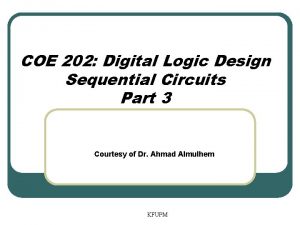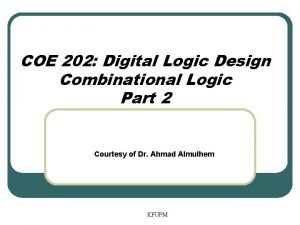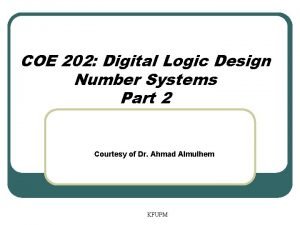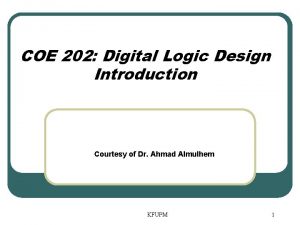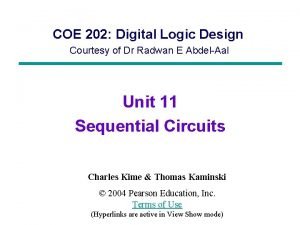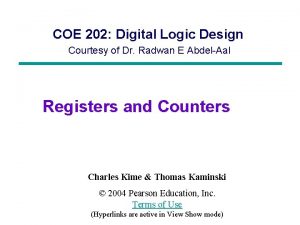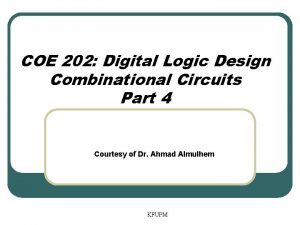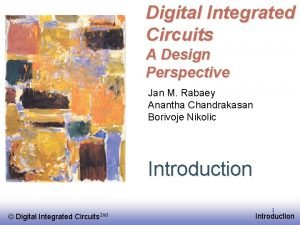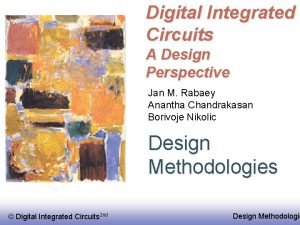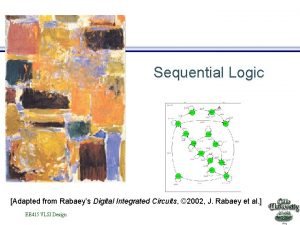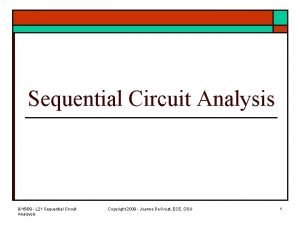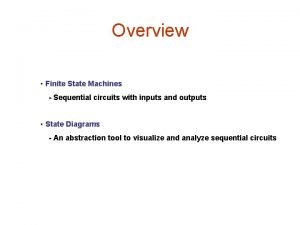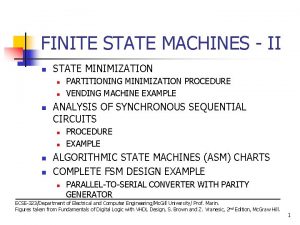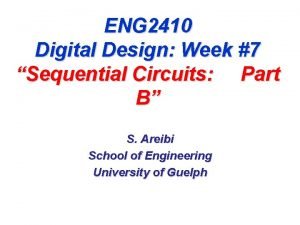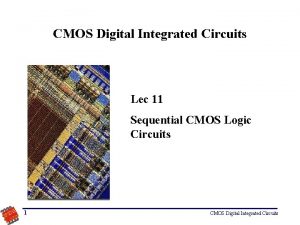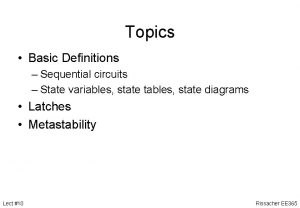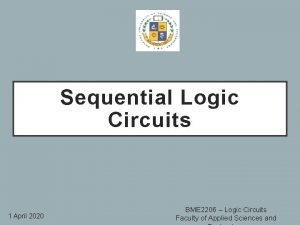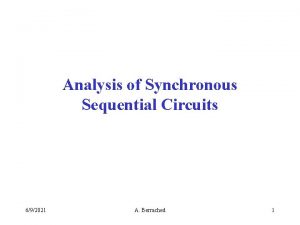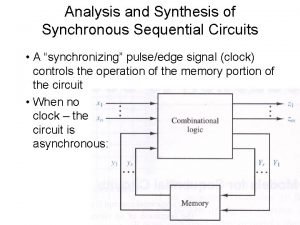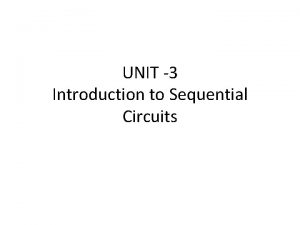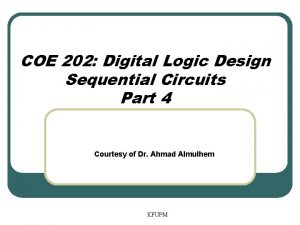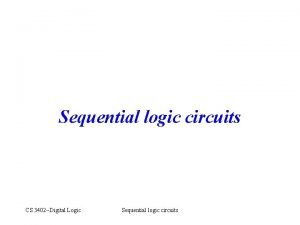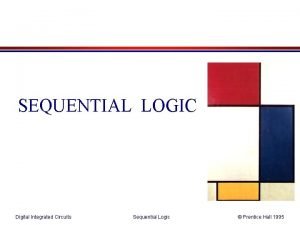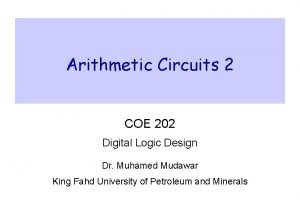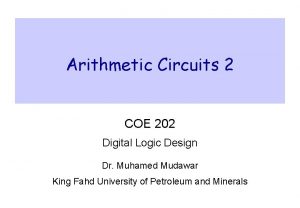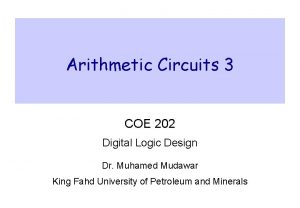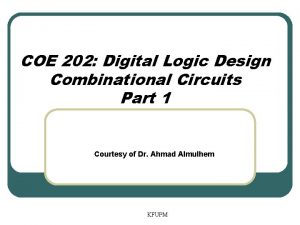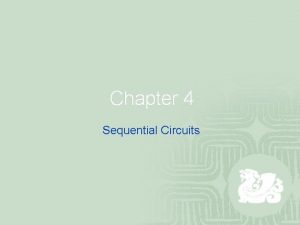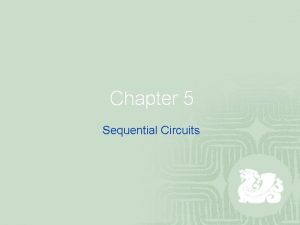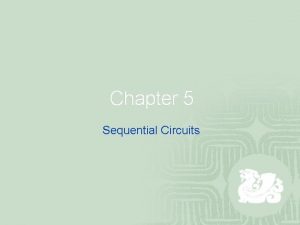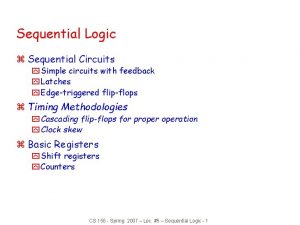Modular Sequential Circuits COE 202 Digital Logic Design





































- Slides: 37

Modular Sequential Circuits COE 202 Digital Logic Design Dr. Muhamed Mudawar King Fahd University of Petroleum and Minerals

Presentation Outline v Registers v Shift Registers and their Applications v Ripple Counters v Synchronous Counters v Memory and ROM Modular Sequential Circuits COE 202 – Digital Logic Design © Muhamed Mudawar – slide 2

Register v 4 -bit Register Modular Sequential Circuits COE 202 – Digital Logic Design © Muhamed Mudawar – slide 3

Register Load (or Enable) v Question: How to control the loading of data into a register? v Solution: Introduce a register Load (or Enable) signal If the register is enabled, load the data into the register Otherwise, do not change the value of the register v Question: How to implement register Load? n-bit Register Modular Sequential Circuits COE 202 – Digital Logic Design © Muhamed Mudawar – slide 4

Register with Parallel Load v 1 0 1 0 Modular Sequential Circuits COE 202 – Digital Logic Design © Muhamed Mudawar – slide 5

Shift Registers v A shift register is a cascade of flip flops sharing the same clock v Allows the data to be shifted from each flip-flop to its neighbor v The output of a flip-flop is connected to the input of its neighbor v Shifting can be done in either direction v All bits are shifted simultaneously at the active edge of the clock Serial Input SI Serial Output SO Right Shift Register Modular Sequential Circuits COE 202 – Digital Logic Design © Muhamed Mudawar – slide 6

Timing of a Shift Register Serial Input SI Serial Output SO Cycle SI Q 3 Q 2 Q 1 Q 0 = SO T 0 1 1 0 T 1 0 1 T 2 1 0 1 1 0 T 3 1 1 0 1 1 T 4 0 1 1 0 1 T 5 1 0 1 1 0 T 6 0 1 1 Modular Sequential Circuits COE 202 – Digital Logic Design © Muhamed Mudawar – slide 7

Shift Register with Parallel Output v The output of a shift register can be serial or parallel v A Serial-In Parallel-Out (SIPO) shift register is shown below v All flip-flop outputs can be read in parallel Serial Input SI Parallel Output PO Modular Sequential Circuits COE 202 – Digital Logic Design © Muhamed Mudawar – slide 8

Bit Serial Adder v Serial Addition Starts at the Least-significant bit Serial Inputs Full Adder Flip Modular Sequential Circuits Flop COE 202 – Digital Logic Design © Muhamed Mudawar – slide 9

Sequence Detector with a Shift Register v A sequence detector can be implemented using: Left Shift Register (SIPO) + AND Gates v Example: Detecting the sequences 1010 and 1100 Bits are shifted left starting at the most-significant bit 1 0 1 0 Serial Input SI Detect 1010 Detect 1100 Modular Sequential Circuits COE 202 – Digital Logic Design © Muhamed Mudawar – slide 10

Parallel-In Serial-Out Shift Register v Parallel Data Input Serial In Control Clock Reset Parallel-In Serial-Out Shift Register Serial Output Modular Sequential Circuits COE 202 – Digital Logic Design © Muhamed Mudawar – slide 11

Parallel In Serial Out Shift Register v Two control functions: s = 0 Shift s = 1 Load data Parallel Data Input Serial Input SI 0 1 0 1 0 1 Serial Output SO Modular Sequential Circuits COE 202 – Digital Logic Design © Muhamed Mudawar – slide 12

Universal Shift Register v R-shift Parallel L-shift Serial Data Serial Input Control 2 Clock Reset Universal Shift Register Parallel Data Output Modular Sequential Circuits COE 202 – Digital Logic Design © Muhamed Mudawar – slide 13

Universal Shift Register Design Parallel Inputs Right-Shift Serial Input Left-Shift Serial Input 2 3210 s=0 No change s=1 Shift Right s=2 Shift Left s=3 Parallel Load Parallel Outputs Modular Sequential Circuits COE 202 – Digital Logic Design © Muhamed Mudawar – slide 14

Counter v Sequential circuit that goes through a specific sequence of states v Output of the counter is the count value v Modulo-N counter: goes through 0, 1, 2, …, (N – 1) v Modulo-8 binary counter: goes through 0, 1, 2, …, 7 v Modulo-10 (BCD) counter: goes through 0, 1, 2, …, 9 v Counting can be up or down v Some Applications: ² Timers Counter ² Event Counting ² Frequency Division Modular Sequential Circuits n COE 202 – Digital Logic Design © Muhamed Mudawar – slide 15

Implementing Counters Two Basic Approaches: 1. Ripple Counters ² The system clock is connected to the clock input of the first flip-flop (LSB) ² Each flip-flop output connects to the clock input of the next flip-flop ² Advantage: simple circuit and low power consumption ² Disadvantage: The counter is not truly synchronous ² No common clock to all flip-flops ² Ripple propagation delay as the clock signal propagates to the MSB 2. Synchronous Counters ² The system clock is connected to the clock input of ALL flip-flops ² Combinational logic is used to implement the desired state sequence Modular Sequential Circuits COE 202 – Digital Logic Design © Muhamed Mudawar – slide 16

Ripple Counter v Q 0 toggles at the positive edge of every cycle v Q 1 toggles when Q 0 goes from 1 down to 0 v Q 2 toggles when Q 1 goes from 1 down to 0 v Q 3 toggles when Q 2 goes from 1 down to 0 Q 3 Q 2 Q 1 Q 0 0 0 0 0 1 1 0 0 0 1 1 0 0 1 0 1 0 Modular Sequential Circuits Counts Up from 0 to 15 then back to 0 COE 202 – Digital Logic Design © Muhamed Mudawar – slide 17

Ripple Counter (cont'd) Up Count 0 0 0 0 1 1 1 1 Modular Sequential Circuits 0 0 1 1 Down Count 0 1 0 1 1 1 1 1 0 0 0 0 1 1 0 0 1 0 1 0 How to Count Down? Connect Q 0 to Clk Q 1 to Clk Q 2 to Clk Q 3 COE 202 – Digital Logic Design © Muhamed Mudawar – slide 18

Timing of a Ripple Counter Clock Q 0 Q 1 Q 2 Q 3 v Drawback of ripple counter: Flip-flops are NOT driven by the same clock (Not Synchronous) Q delay increases as we go from Q 0 to Q 3 Given = flip-flop delay Delay of Q 0, Q 1, Q 2, Q 3 = , 2 , 3 , 4 Modular Sequential Circuits COE 202 – Digital Logic Design © Muhamed Mudawar – slide 19

Synchronous Counter v n-bit Incrementer (+1) n-bit Register Modular Sequential Circuits COE 202 – Digital Logic Design © Muhamed Mudawar – slide 20

4 -Bit Synchronous Counter with Enable v An incrementer is a reduced (contracted) form of an adder 4 -Bit Incrementer EN = 0 No Change EN = 1 Increment How to Count Down? Increment Q' (Not Q) 4 -bit Counter Output Modular Sequential Circuits COE 202 – Digital Logic Design © Muhamed Mudawar – slide 21

Timing of a Synchronous Counter Clock Q 0 Q 1 Q 2 Q 3 v Advantage of Synchronous counter: ALL Flip-flops are driven by the same clock Delay of all outputs is identical Delay of Q 0 = Q 1 = Q 2 = Q 3 = Modular Sequential Circuits COE 202 – Digital Logic Design © Muhamed Mudawar – slide 22

Frequency Division v A counter can be used as a frequency divider v Counter is driven by a Clock with frequency F v Output Q 0 Frequency = F/2, Output Q 1 Frequency = F/4 v Output Q 2 Frequency = F/8, Output Q 3 Frequency = F/16 Clock Q 0 Q 1 Q 2 Q 3 Modular Sequential Circuits COE 202 – Digital Logic Design © Muhamed Mudawar – slide 23

BCD Counter v Problem: Convert a 4 -bit binary counter into a BCD counter v Solution: When output reaches 9 then reset back to 0 v Asynchronous Reset: Count to 10 and reset immediately 4 -bit Counter with Synchronous Reset (Asynchronous) COE 202 – Digital Logic Design 1 4 -bit Counter (Synchronous) Modular Sequential Circuits 1 4 -bit Counter with Asynchronous Reset © Muhamed Mudawar – slide 24

Building Larger Synchronous Counters v 4 -bit Counter 4 Modular Sequential Circuits 4 -bit Counter 4 COE 202 – Digital Logic Design 4 © Muhamed Mudawar – slide 25

Synchronous Counter with Parallel Load v Ability to load an initial binary number into the counter ² Prior to the count operation v Two control inputs: ² Load: Initialize counter with input Data ² EN: enables the counting 4 Very useful in implementing different counting sequences 4 -bit Counter 4 Modular Sequential Circuits COE 202 – Digital Logic Design © Muhamed Mudawar – slide 26

Implementing a Counter with Parallel Load 0 1 Load EN Action 0 0 No change 0 1 Increment Count 1 X Load data 0 1 4 -bit Counter Output Modular Sequential Circuits COE 202 – Digital Logic Design © Muhamed Mudawar – slide 27

3 -to-12 Counter v Convert a 4 -bit binary counter with load into 3 -to-12 counter v Solution: Detect binary count 12 and then load 3 v Detect 12: Binary count with Q 3 = Q 2 = 1 0 0 1 1 4 -bit Counter Synchronous Preset Load: 0011 Modular Sequential Circuits COE 202 – Digital Logic Design © Muhamed Mudawar – slide 28

9 -to-99 Counter Problem: Use two 4 -bit binary counters with parallel load and logic gates to build a counter that counts from 9 to 99 = 'b 01100011 Add a synchronous Preset input to initialize the counter to value 9 0 1 0 0 1 4 -bit Counter Modular Sequential Circuits COE 202 – Digital Logic Design © Muhamed Mudawar – slide 29

Memory v Large array or storage cells, capable of storing many 0's and 1's v Random Access Memory: bits can be accessed randomly v Memory is addressable Data_in Memory address consists of k bits Can address 2 k words in memory n Address Each word consists of n bits Read v Memory capacity = 2 k × n bits Write v Two control functions: Read and Write Read: Data_out Memory [Address] k Memory Unit 2 k × n bits n Data_out Write: Memory [Address] Data_in Modular Sequential Circuits COE 202 – Digital Logic Design © Muhamed Mudawar – slide 30

RAM, ROM, EEPROM, and Flash v RAM: Random Access Memory Can be read and written using Read/Write operations Volatile: data is lost when power is turned off v ROM: Read Only Memory (No Write operation) Mask programming by the circuit manufacturer (not by the user) Non-Volatile Memory (NVM): data is permanent v EEPROM: Electrically Erasable Programmable ROM Can be erased and reprogrammed by the user (special write) EEPROM Programmer: Device that writes the EEPROM v Flash: Non-Volatile Memory that can be read and written Modular Sequential Circuits COE 202 – Digital Logic Design © Muhamed Mudawar – slide 31

ROM Memory v Address consists of k bits 2 k memory addresses v At each memory address, there is a word consisting of n bits v The n-bit word appears at the data output of the ROM v ROM does not have data inputs or a write operation Address k ROM 2 k × n bits n Data_out v ROM memory is useful for implementing Boolean Functions v Also useful for storing permanent data Modular Sequential Circuits COE 202 – Digital Logic Design © Muhamed Mudawar – slide 32

ROM Internal Structure (32 x 8 -bit) v 5 -bit Address 5 -to-32 line decoder (Only one line is selected) A 4 A 3 A 2 A 1 A 0 5 -to-32 decoder v Each line = 8 bits 8 -bit Data output 0 1 2 3 28 29 30 31 Bits are stored at the intersection of horizontal and vertical wires . . . 32 -input OR Gate D 7 Modular Sequential Circuits D 6 D 5 D 4 D 3 COE 202 – Digital Logic Design D 2 D 1 D 0 © Muhamed Mudawar – slide 33

Implementing a Combinational Circuit v Implementing a Combinational Circuit with a ROM is easy v Store the truth table of the circuit by programming the ROM Truth Table with Five Inputs and Eight output functions I 4 I 3 I 2 I 1 I 0 F 7 F 6 F 5 F 4 F 3 F 2 F 1 F 0 0 0 0 0 1 0 0 1 0 0 0 1 · · · 1 1 1 0 0 1 1 0 1 0 0 0 1 1 0 0 · · · 1 0 0 0 1 0 Inputs are used as Address lines to the ROM Modular Sequential Circuits COE 202 – Digital Logic Design © Muhamed Mudawar – slide 34

Programming a ROM Every 1 in the truth table X (CLOSED) connection Every 0 in the truth table NO connection A 4 A 3 A 2 A 1 A 0 5 -to-32 decoder Example: At address 00011 = (decimal 3), the word 10110010 is stored 0 1 2 3 28 29 30 31 x. . . x x x x x x x 001110000110 010110010 01000001 1100 10110011 0010 32 -input OR Gate D 7 Modular Sequential Circuits D 6 D 5 D 4 D 3 COE 202 – Digital Logic Design D 2 D 1 D 0 © Muhamed Mudawar – slide 35

Example: Square Function v Design a square function with a ROM v Input X = 3 -bit number, Output Y = X 2 v Solution: Derive the Truth Table X 2 X 1 X 0 Modular Sequential Circuits Square Y 5 Y 4 Y 3 Y 2 Y 1 Y 0 0 0 0 1 1 0 0 0 1 0 4 0 0 0 1 1 9 0 0 1 1 0 0 16 0 1 0 1 25 0 1 1 0 0 1 1 1 0 36 1 0 0 1 1 1 49 1 1 0 0 0 1 COE 202 – Digital Logic Design © Muhamed Mudawar – slide 36

ROM Table v Output Y 0 is identical to input X 0 No need to store in ROM v Similarly, Output Y 1 is always 0 No need to store in ROM v ROM table Only need to store Y 5, Y 4, Y 3, and Y 2 in ROM X 2 X 1 X 0 Y 5 Y 4 Y 3 Y 2 Y 1 Y 0 0 0 1 0 0 0 1 0 0 0 1 1 0 0 0 0 1 0 1 1 0 0 1 0 0 1 1 1 0 0 0 1 Modular Sequential Circuits COE 202 – Digital Logic Design Minimal ROM Size = 23 × 4 bits X 2 X 1 X 0 Y 5 8× 4 ROM Y 4 Y 3 Y 2 0 Y 1 Y 0 © Muhamed Mudawar – slide 37
 Coe 202 kfupm
Coe 202 kfupm Pos expression can be implemented using
Pos expression can be implemented using Consensus theorem
Consensus theorem Coe 202
Coe 202 Coe202
Coe202 Coe 202
Coe 202 State diagram truth table
State diagram truth table Coe 202
Coe 202 202
202 Coe 202
Coe 202 Coe 202
Coe 202 Coe 202 unlv
Coe 202 unlv Coe 202
Coe 202 X3b2a
X3b2a Combinational logic vs sequential logic
Combinational logic vs sequential logic Software development plan
Software development plan Is it x y or y x
Is it x y or y x Combinational logic sequential logic 차이
Combinational logic sequential logic 차이 Logic chapter 3
Logic chapter 3 Coe logic
Coe logic Sequential modular approach
Sequential modular approach Digital integrated circuits a design perspective
Digital integrated circuits a design perspective Digital integrated circuits a design perspective
Digital integrated circuits a design perspective Digital integrated circuits a design perspective
Digital integrated circuits a design perspective Non bistable sequential circuits
Non bistable sequential circuits Sequential circuit analysis
Sequential circuit analysis Synchronous sequential circuits examples
Synchronous sequential circuits examples Finite state machine sequential circuits
Finite state machine sequential circuits Vending machine asm chart
Vending machine asm chart Analysis of sequential circuits
Analysis of sequential circuits Non bistable sequential circuits
Non bistable sequential circuits Sequential circuits prelude
Sequential circuits prelude Sequential circuits
Sequential circuits State diagram
State diagram Analysis of synchronous sequential circuits
Analysis of synchronous sequential circuits Synthesis of synchronous sequential circuits
Synthesis of synchronous sequential circuits D flip flop
D flip flop Mealy moore
Mealy moore
